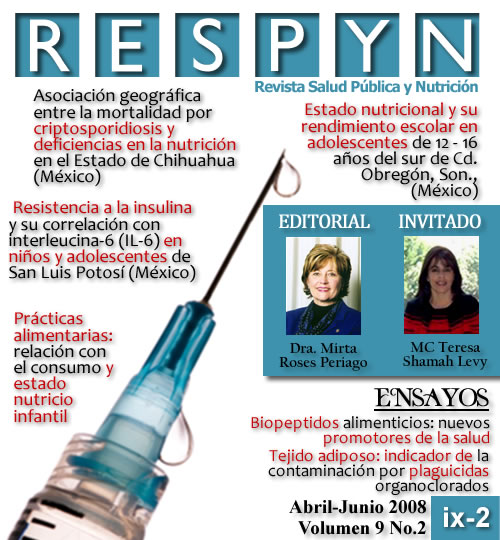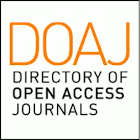TEJIDO ADIPOSO: INDICADOR DE LA CONTAMINACIÓN POR PLAGUICIDAS ORGANOCLORADOS
Resumen
Los insecticidas organoclorados, los de mayor importancia por sus propiedades de biomagnificación en la cadena trófica, son el DDT, su metabolito el DDE y el isómero -HCH. Las rutas de ingreso al organismo humano de los plaguicidas persistentes comprenden la inhalación de sus vapores y la ingesta de alimentos contaminados. El monitoreo de tejidos humanos proporciona datos sobre la dosis acumulativa durante el
transcurso del tiempo, a través de todas las rutas ambientales de exposición. El tejido adiposo se ha seleccionado como el idóneo en los estudios de monitoreo, ya que esta compuesto de una gran cantidad de grasa neutra y por la capacidad de almacenar los plaguicidas persistentes.
Palabras clave: tejido adiposo, bioindicador, plaguicidas organoclorados
adipose tissue,bioindicator, organochlorine pesticides
Descargas
Citas
Worthing Ch.R. y R.J. Hance 1991. The Pesticide Manual. A World Compendium. Nine edition. The British Crop Protection Council, Surrey, Great Britain
Anónimo 1989. DDT and its derivatives - environmental aspects. Environm. Hlth. Criteria 83. WHO, Geneva
Alegría H., F. Wong, T. Bidleman, M. Salvador Figueroa, G. Gold-Boucholt, S. Waliszewski, V. Ceja Moreno and R. Infanzón 2005. Ambient air levels of organochlorine pesticidas in air in southern Mexico. En: Botello A.V., Rendón von Osten J. Gold Boucholt G. y Agraz hernandez C. eds., Golfo de México Contaminación e Impacto
Ambiental. Tendencias y diagnóstico 2ª edición. Universidad Autónoma de Campeche (México)
Idem.
Waliszewski S.M., A.A. Aguirre, R.M. Infanzón and J. Siliceo 2000. Carry-over of persistent organochlorine pesticides through placenta to fetus. Salud Pública de México Vol. 42 No. 5: 384-390.
Waliszewski S.M., S. Gómez-Arroyo, R.M. Infanzón, O. Carvajal, R. Villalobos-Pietrini, P. Trujillo and M. Maxwell 2004. Persistent organochlorine pesticide levels in bovine fat from Mexico. Food Additives and Contaminants Vol. 21 No.8: 774-780.
Waliszewski S.M., R.M. Infanzón, S. Gomez-Arroyo, R. Villalobos-Pietrini, O. Carvajal, P. Trujillo, and P.M Hayward-Jones 2005. Persistent organochlorine pesticides levels in blood serum lipids in women bearing babies with undescended testis. Bul. Environ. Contam. Toxicol. Vol.75 No.5: 952-959.
Waliszewski S.M., M.T. Bermúdez, C.S. Silva, R.M. Infanzón, O. Carvajal, S. Gómez Arroyo, R. Villalobos, R. Pietrini, V. Saldaña, G. Melo, S. Esquivel, F. Castro, H. Ocampo, J. Torres and P.M. Hayward-Jones 2005. DDT’s, HCH and HCB levels in breast adipose tissue in women with breast tumors. Revista Internacional de Ciencias Ambientales Vol. 21 No.3: 133-142.
Ott, W.R. 1985. Total human exposure. Environ. Sci. Technol. Vol.19: 880-886.
Lioy, P.J. 1990. Assessing total human exposure to contaminants. A multidisciplinary approach. Environ.
Sci. Technol. Vol.24: 938-945.
O'Hara T.M., M.M. Krahn, D. Boyd, P.R. Becker and L.M.J. Philo 1999. Organochlorine contaminant levels in Eskimo harvested bowhead whales of arctic Alaska. Wildl. Dis. Vol. 35 No. 4: 741-752.
Cohn B.A., M.S. Wolff, P.M. Cirillo and R.I. Sholtz 2007. DDT and breast cancer in young women: New data on the significance ao age at exposure. Environm. Hlth. Perspect. Vol. 115 No.10: 1406-1414.
Hulka B.S. 1990. Overview of biological markers. In: Biological Markers in Epidemiology. (Hulka, B.S.; Wilcosky, T.C. y Griffith, J.D. eds.). Oxford University Press, New York pp. 3-15.
Cohn, B.A., et al, Op. cit.
Wolff M.S., P.G. Toniolo, E.W. Lee, M. Rivera and N. Dubin 1993. Blood levels of organochlorine residues and risk of breast cancer. J. Natl. Cancer Inst. Vol.85: 648-652.
Krieger N., M.S. Wolff, R. A. Hiatt, M. Rivera, J. Vogelman and N. Orentreich 1994. Breast cancer and serum organochlorines: a prospective study among white, black, and Asian women. J. Natl. Cancer Inst. Vol. 86: 589- 599.
Hellerstein M.K., M. Christiansen, S. Kaempfer, C. Kletke, K. Wu, J.S Reid, K. Mulligan, N.S. Hellerstein and C.H.L. Shackleton 1991. Measurement of de novo hepatic lipogenesis in humans using stable isotopes. J. Clin. Invest. Vol. 87: 1841-1852.
Waliszewski S.M., S. Gómez-Arroyo, R.M. Infanzón, R. Villalobos-Pietrini and M. Maxwell Hart 2003. Comparison of organochlorine pesticide levels between abdominal and breast adipose tissue. Bull. Environ. Contam. Toxicol. Vol. 71 No.1: 156-162.
Waliszewski S.M., V.T. Pardío Sedas, J.N. Chantiri Pérez, R.M. Infanzon Ruíz y J. Rivera 1995. Evaluación de los niveles de DDT y HCH en el tejido adiposo de algunas personas fallecidas en el Estado de Veracruz, México. Rev. Int. Contam. Ambient. Vol.11 No.2: 87-93.
Idem.
Schäfer, L. And K. Overvad 1990. Subcutaneous adipose-tissue fatty acids and vitamin E in humans: relation to diet and sampling site. Am. J. Clin. Nutr. Vol.52: 486-490.
Lands W.E.M., A. Morris and B. Libelt 1990. Quantitative effects of polyunsaturated fats on the composition of fatty acids in rats tisues. Lipids Vol. 12: 505-516.
Schäfer, L. and K. Overvad, Op. cit.
Castignani G.L. and J.G. Bieri 1983. Simultaneous determination of retinol and alfa-tocopherol in serum or plasma by liquid chromatography. Clin. Chem. Vol.29: 708-712.
Sempos C.T., R.R. Briefel, K.M. Flegal, C.L. Johnson, R.S. Murphy and C.E. Woteki 1992. Factors involved in selecting a dietary survey methodology for national nutrition surveys. Aust. J. Nutr. Dis. Vol.49: 96-105
Descargas
Publicado
Cómo citar
Número
Sección
Licencia
Los derechos del trabajo pertenecen al autor o autores, sin embargo, al enviarlo a publicación en la Revista Salud Pública y Nutrición de la Facultad de Salud Pública y Nutrición de la Universidad Autónoma de Nuevo León, le otorgan el derecho para su primera publicación en medio electrónico, y posiblemente, en medio impreso a la Revista Salud Pública y Nutrición. La licencia que se utiliza es la de atribución de Creative Commons , que permite a terceros utilizar lo publicado siempre que se mencione la autoría del trabajo y a la primera publicación que es en la Revista Salud Pública y Nutrición. Asimismo, el o los autores tendrán en cuenta que no estará permitido enviar la publicación a ninguna otra revista, sin importar el formato. Los autores estarán en posibilidad de realizar otros acuerdos contractuales independientes y adicionales para la distribución no exclusiva de la versión del artículo publicado en la Revista Salud Pública y Nutrición (p. ej., repositorio institucional o publicación en un libro) siempre que indiquen claramente que el trabajo se publicó por primera vez en la Revista Salud Pública, Revista de la Facultad de Salud Pública y Nutrición de la Universidad Autónoma de Nuevo León.










